| Previous :: Next Topic |
| Author |
Message |
Eric Gilbertson
Member


Joined: 04 Jul 2018
Posts: 188 | TRs | Pics
Location: Seattle |
Buckner Mountain (9,112ft) and Booker Mountain (8,280ft)
Sept 3, 2022
25 miles, 11kft gain
3am to 7:30pm
Summary of results: Inconclusive whether SW or NE summit is higher. Within error of 5x sight level. More precise measurements are needed.
Buckner Mountain is the 14th highest peak in Washington, the highest point in Skagit County, and one of the few 9,000ers in the state. However, as far as I've researched, the location of the true summit of Buckner is not known with complete certainty. Buckner has two summits separated horizontally by about 600 feet, and both lie within the same 9080ft-9120ft contour lines on the USGS quad. The northeast summit is surveyed as 9112ft on the quad but the southwest summit is not surveyed.
 On Buckner SW summit  The route  The quad showing summit locations (image from peakbagger.com) 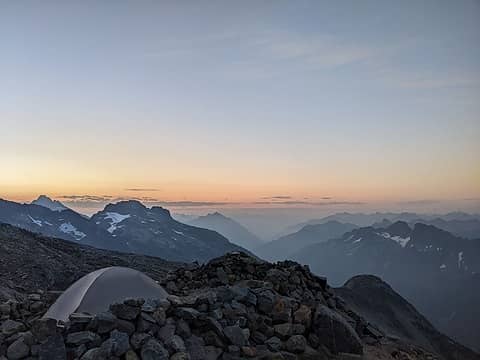 Sunrise from Sahale camp 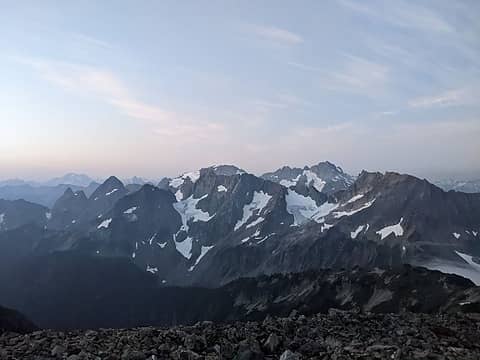 View towards Formidable, Spider, Gunsight, Agnes 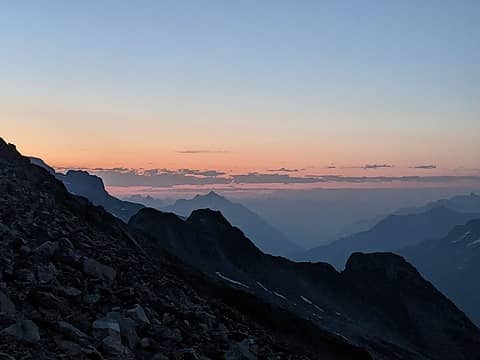 More sunrise views  Panorama from Sahale camp 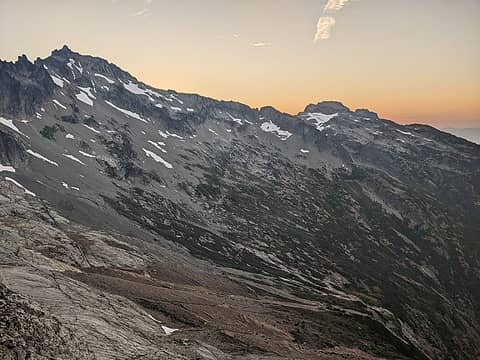 The view from the rib - Buckner on the left, Booker on the right 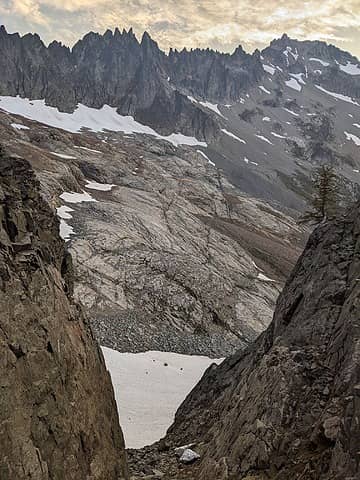 Looking down the descent gully with Buckner on the right 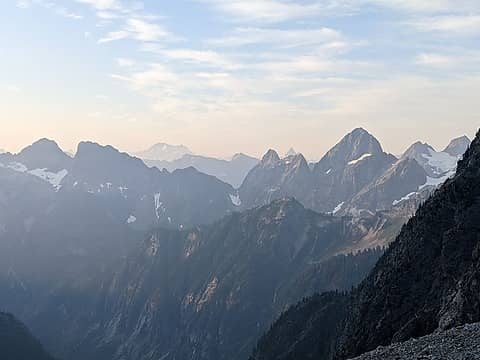 Bonanza in the distance 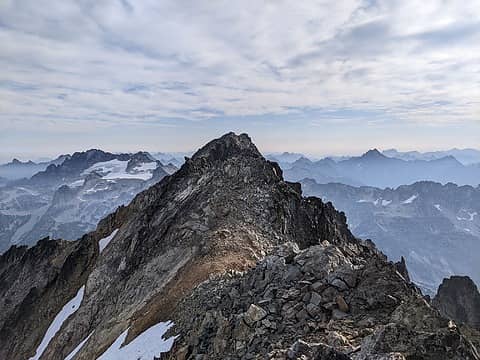 Looking along the ridge towards the NE summit 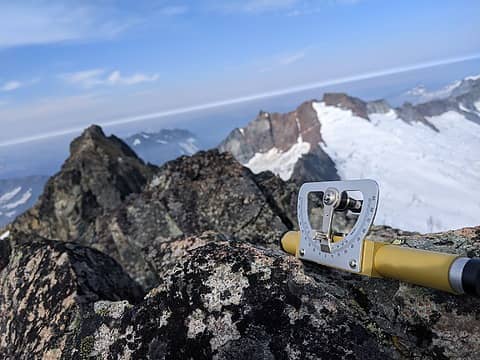 Looking from the NE summit to the SW summit 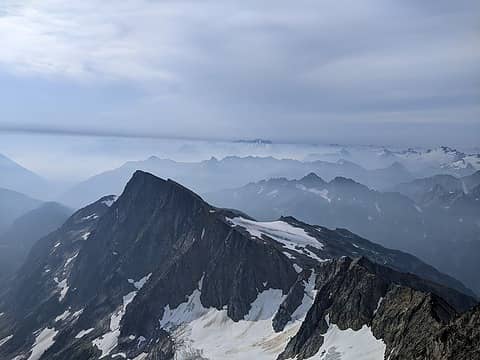 Good views of Booker  Panorama from SW summit 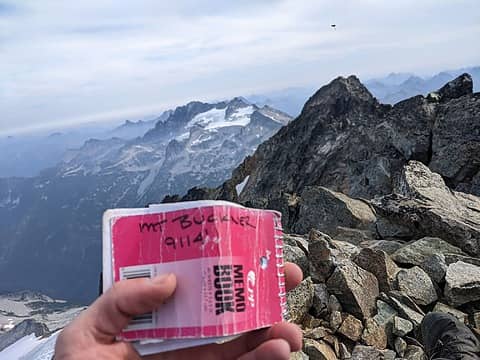 On the SW summit 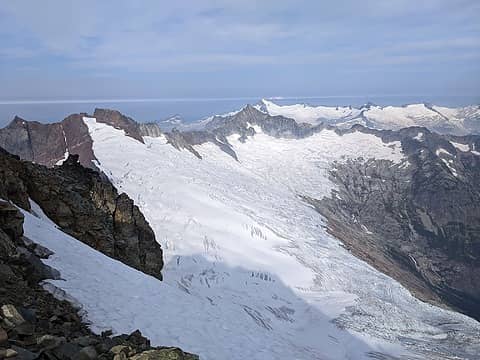 Looking north across the Boston Glacier towards Forbidden, Eldo, and Baker 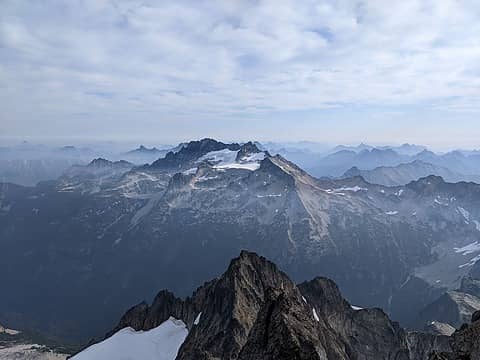 Mt Logan in the distance 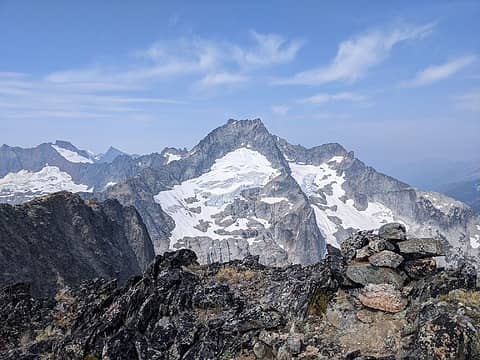 The view of Buckner from on top of Booker. You can clearly see the SW summit on left and NE summit on right 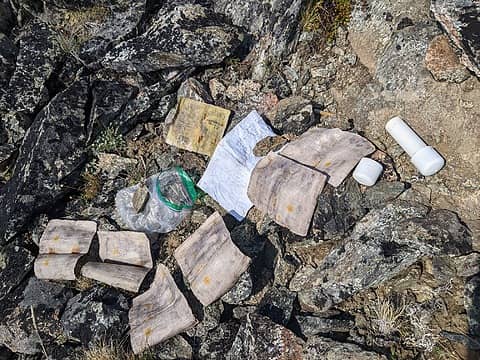 Drying out the register 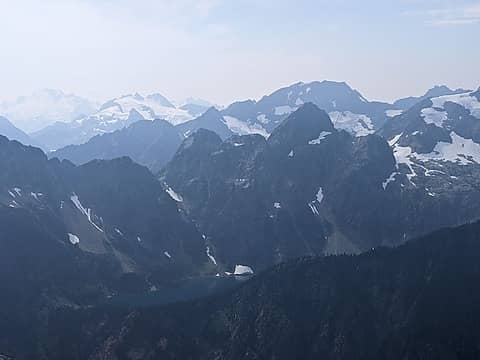 Looking across at Trapper Lake  Summit panorama  Looking back across Horseshoe basin  The snowfield to get past below Sahale camp 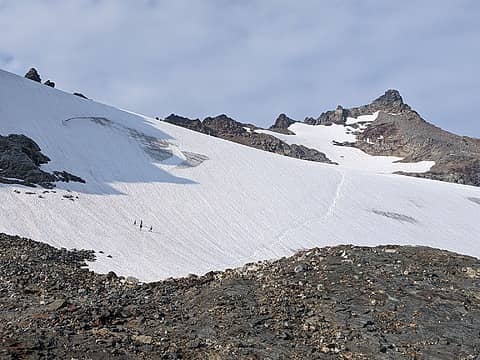 Looking back up at Sahale 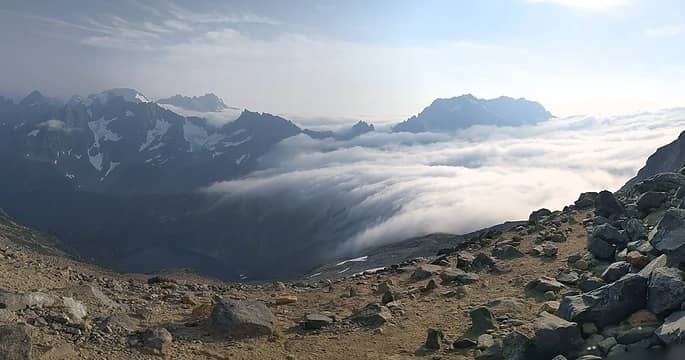 The sea of clouds flowing over Cascade Pass
 wallorcrawl, tomahawksplitter, geyer, zimmertr, Bluebird, vk, raising3hikers, ozzy, glenoid, Josh Journey, RichP, hikergirl1234 wallorcrawl, tomahawksplitter, geyer, zimmertr, Bluebird, vk, raising3hikers, ozzy, glenoid, Josh Journey, RichP, hikergirl1234  ~*CutebutChossy69*~, Gimpilator, awilsondc ~*CutebutChossy69*~, Gimpilator, awilsondc
 wallorcrawl, tomahawksplitter, geyer, zimmertr, Bluebird, vk, raising3hikers, ozzy, glenoid, Josh Journey, RichP, hikergirl1234 wallorcrawl, tomahawksplitter, geyer, zimmertr, Bluebird, vk, raising3hikers, ozzy, glenoid, Josh Journey, RichP, hikergirl1234  ~*CutebutChossy69*~, Gimpilator, awilsondc ~*CutebutChossy69*~, Gimpilator, awilsondc |
| Back to top |
  
|
 |
Worthington
Member


Joined: 23 Jun 2021
Posts: 80 | TRs | Pics
|
If someone spent 30 minutes removing the highest rocks from the SW summit, and another 30 minutes stacking rocks up around the NE summit, wouldn't that be enough to make the difference and settle the matter?
Is that kind of thing frowned upon?
 Alden Ryno Alden Ryno
 Alden Ryno Alden Ryno |
| Back to top |
  
|
 |
Paul Mayes
Member


Joined: 03 Sep 2022
Posts: 2 | TRs | Pics
|
This calls for another trip up Buckner! I was tired after Horseshoe and didn't tag the NE summit when I was up there in July. At the time, I was satisfied with the previous measurements.
I have also looked for the remains of that big tree at MP 15, but I think the NPS probably moved it with an excavator or other heavy equipment that they took up there for road work. The root ball was blocking the ditch and part of the road.
I took this looking your way on Saturday at 11:42am from Sahale. You're in there somewhere, but it's a low quality photo.
|
| Back to top |
  
|
 |
RichP
Member


Joined: 13 Jul 2006
Posts: 5634 | TRs | Pics
Location: here |
 |
RichP
Member
|
 Mon Sep 05, 2022 7:31 am |
|
|
I can just hear the sigh of relief of all those who can still claim they have climbed the highpoint of Buckner (so far). Very entertaining read, Eric.
He Devil and She Devil could be two more candidates for such treatment. As far as I know, it's still unresolved which is higher.
 Alden Ryno Alden Ryno
 Alden Ryno Alden Ryno |
| Back to top |
  
|
 |
SeanSullivan86
Member


Joined: 25 Jul 2009
Posts: 681 | TRs | Pics
Location: Seattle, WA |
FWIW, I recall that EE's photo analysis app did output error bounds. I believe they were related to the angular resolution of a pixel in the image and/or the errors observed by using all-but-one of the known summits in the image to estimate the angle/elevation of another known summits. The atmospheric effects seem like the main issue with that visual technique.
|
| Back to top |
  
|
 |
glenoid
Member

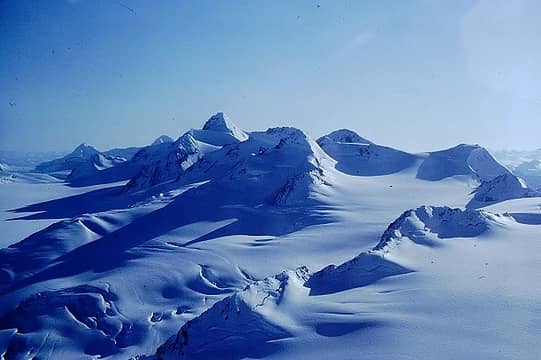
Joined: 30 Oct 2012
Posts: 307 | TRs | Pics
|
 |
glenoid
Member
|
 Mon Sep 05, 2022 1:16 pm |
|
|
Nice TR!! Refreshed my memory of my trip there in early July 1978. Went the exact same way to Buckner. The weather seemed about the same also. Watched the clouds roll in over Cascade Pass from a campsite below Sahale, but they never got near our route under Ripsaw ridge to Buckner. (Back then, no one else was around. Pure solitude...)
 ~*CutebutChossy69*~ ~*CutebutChossy69*~
 ~*CutebutChossy69*~ ~*CutebutChossy69*~ |
| Back to top |
  
|
 |
Eric
Peak Geek


Joined: 21 Oct 2002
Posts: 2062 | TRs | Pics
Location: In Travel Status |
 |
Eric
Peak Geek
|
 Mon Sep 05, 2022 6:42 pm |
|
|
| Eric Gilbertson wrote: | | As far as Iíve researched, there have only been three instances of measurements taken to try to settle the controversy. Edward Earl analyzed a picture taken from the SW summit looking toward the NE summit. By knowing elevations of peaks in the background and the distance between the peaks he could estimate the angle between the camera and the NE summit, and then estimate the height difference. He estimated the NE summit was 1ft shorter.
In 2018 Greg Slayden and Jobe Wymore took 5x sight levels to Buckner. From the SW summit looking at the NE summit they both measured the NE summit a little shorter. Greg scrambled to the NE summit and backsighted the SW summit and measured the SW summit a little higher. He estimated 1-2ft. (Jobe didnít back sight).
At face value this sounds definitive, that the SW summit is higher. But I wasnít completely convinced. In my experience with 5x sight levels itís possible to at best resolve about 0.1-0.2 degrees of angular inclination or declination. With a 600ft horizontal distance, using a bit of trigonometry, a 0.1-0.2 degree angular declination results in a 1-2ft height difference. So the measured difference is right at the border of the resolution of the measuring device. But, without a proper tripod mount, a 5x sight level is a bit more prone to error from hand vibrations and roll angular error. That could be significant when operating very close to the resolution.
As far as Iíve heard, the photo analysis was only in one direction Ė SW looking towards NE summit. I would have much more confidence in this measurement if it were backed up by one from the NE looking at the SW summit, and if error bounds were given. I would also have more confidence if more than one sight level measurement with backsighting measured the SW summit higher, since it is so close to the resolution of the device. Or if more precise measurements were taken. |
Without combing through all of the old emails I believe that Edward ran the pixel analysis on a photo that Greg took on their summit of Buckner together in 2008. I recall he came up with a figure of 9.6 inches that the SW peak would be higher using his pixel analysis though that does not quite align with Greg's later email. I am certain Greg and Roper were on these email chains too, they may have it more readily available. Anyway, in 2018, Greg returned and his email states:
Also, in 2008 I had taken a photograph of the NE peak from the SW peak that was analyzed by Edward Earlís ďGeoPixĒ program. This program used background points and their known latitude, longitude, and elevations to estimate that the SW summit was approximately 2.32 feet higher than the NE summit. When I visited the NE summit, I took a photo back to the SW summit, and when I got home I ran the GeoPix program on the new photo with its background points The results from the new photo were that the NE summit is about 2.24 feet lower than the SW one. The newer photo was at a lower resolution and the confidence level was not as high as before, but I believe that the consistency of the two results shows that GeoPix is a valid tool for this kind of analysis.
If anyone is interested, I can share the 2 photos, the input and output files, the GeoPix code, and its documentation. I would be happy to answer any questions about these results.
So it sounds like 3 photos were analyzed with two from the SW and one back to the NE between the two trips. It also appears that Greg maintained, at least as of four years ago, the code and was willing to share it so perhaps some of the photos taken here could be utilized for that purpose.
(they can be rented for ~$200/day, but Iím not sure I want to invest that in this project yet). I imagine there are interested parties in the COHP community as well as Roper, Greg, myself and many others since this also impacts a great number of Bulger finishers as it seems the majority of folks only go to the SW summit. I will match whatever Roper donates to the cause up to a $100 bucks!  Of course the harder part is lugging it back up the mountain. I won't be helping with that! Of course the harder part is lugging it back up the mountain. I won't be helping with that!
| Eric Gilbertson wrote: | | Alternatively, a hose level could get 1 inch accuracy, but that is not practical because it would be way to0 heavy to lug so much water up to fill a 600ft long hose. |
I had the opportunity to join Edward and Greg once for an effort to hose level the summit of Indian Rock. It was very interesting to see but we used a shorter hose and did loops as best we could, but it likely reduced the accuracy a bit. {Someone else later took professional WA DOT surveying equipment up there too!} Agree with your point, in practice the weight is a lot and brush and rocks proved problematic and that was on a flat plateau. The Trimble seems like the best option, until we get LiDAR or something better.
 Alden Ryno Alden Ryno
 Alden Ryno Alden Ryno |
| Back to top |
  
|
 |
raising3hikers
Member


Joined: 21 Sep 2007
Posts: 2344 | TRs | Pics
Location: Edmonds, Wa |
Nice work, glad you're recovering from your K2 trip
Eric Eames
 Eric Gilbertson Eric Gilbertson
Eric Eames
 Eric Gilbertson Eric Gilbertson
|
| Back to top |
  
|
 |
Eric Gilbertson
Member


Joined: 04 Jul 2018
Posts: 188 | TRs | Pics
Location: Seattle |
| Quote: | | If someone spent 30 minutes removing the highest rocks from the SW summit, and another 30 minutes stacking rocks up around the NE summit, wouldn't that be enough to make the difference and settle the matter?
Is that kind of thing frowned upon? |
Haha, I heard something like that happened on two Colorado 14ers. Seems like it was Mt Harvard and Mt Columbia but I might be remembering wrong and now I can't find detail about it online. One group would build a big cairn on one so it was highest, then next weekend another group would knock the cairn over and build a bigger one on the other peak so it was highest. I'm pretty sure most peakbaggers only count natural rock, not human-piled rocks, as the true top, though.
| Quote: | | Also, in 2008 I had taken a photograph of the NE peak from the SW peak that was analyzed by Edward Earlís ďGeoPixĒ program. This program used background points and their known latitude, longitude, and elevations to estimate that the SW summit was approximately 2.32 feet higher than the NE summit. When I visited the NE summit, I took a photo back to the SW summit, and when I got home I ran the GeoPix program on the new photo with its background points The results from the new photo were that the NE summit is about 2.24 feet lower than the SW one. The newer photo was at a lower resolution and the confidence level was not as high as before, but I believe that the consistency of the two results shows that GeoPix is a valid tool for this kind of analysis.
If anyone is interested, I can share the 2 photos, the input and output files, the GeoPix code, and its documentation. I would be happy to answer any questions about these results.
So it sounds like 3 photos were analyzed with two from the SW and one back to the NE between the two trips. It also appears that Greg maintained, at least as of four years ago, the code and was willing to share it so perhaps some of the photos taken here could be utilized for that purpose. |
Yes, Greg gave me the code and I'm looking through it now. Looks to me like the output is actually SW 2.24 ft higher than NE, and NE 0.8ft shorter than SW, if I'm interpreting it correctly. There are many correction factors for atmospheric effects for things like temperature, pressure, wind, haze, etc, which all sound like potential sources of error to me. I'll have to dig into the code more to understand it better though and see what the error bounds are.
At least for me a standard angular declination/inclination measurement seems the most trustworthy and confidence-inspiring. I think a theodolite is probably the way to go. They can get 1 arcsecond angular resolution with 30x magnification. That translates to 0.03 inches at 600ft horizontal distance!
| Quote: | | I took this looking your way on Saturday at 11:42am from Sahale. You're in there somewhere, but it's a low quality photo. |
Nice photo! I think I'm at the red circle:
 geyer geyer
 geyer geyer |
| Back to top |
  
|
 |
Gimpilator
infinity/21M


Joined: 12 Oct 2006
Posts: 1684 | TRs | Pics
Location: Edmonds, WA |
Thanks Eric. This has been a long contentious issue, brining much debate. In light of your findings, I'm even more satisfied having only visited the SW summit.
|
| Back to top |
  
|
 |
zimmertr
TJ Zimmerman

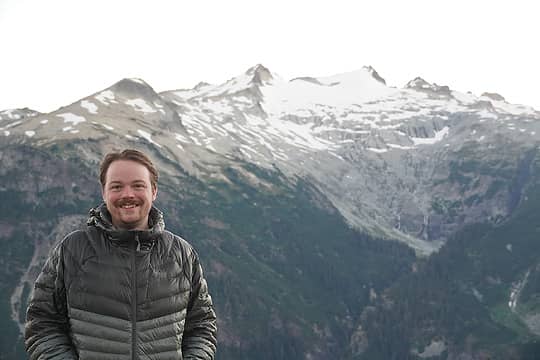
Joined: 24 Jun 2018
Posts: 1227 | TRs | Pics
Location: Issaquah |
 |
zimmertr
TJ Zimmerman
|
 Mon Oct 17, 2022 6:31 pm |
|
|
If you ever felt up to it, I think it is also contested whether or not the two Enchantment Peak summits are of equal elevation. And one is significantly easier than the other.
|
| Back to top |
  
|
 |
|
|
You cannot post new topics in this forum
You cannot reply to topics in this forum
You cannot edit your posts in this forum
You cannot delete your posts in this forum
You cannot vote in polls in this forum
|
Disclosure: As an Amazon Associate NWHikers.net earns from qualifying purchases when you use our link(s). |